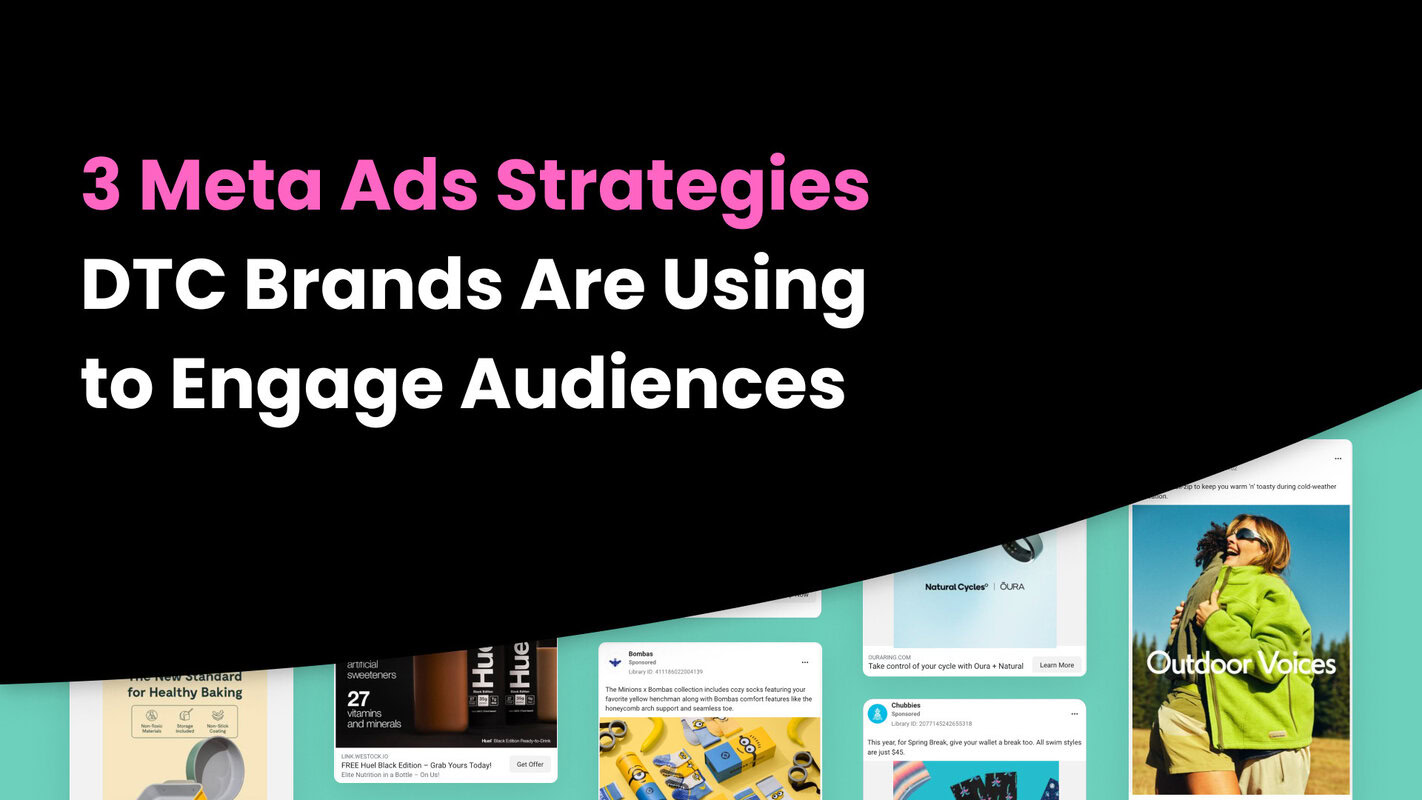When it comes to digital ads, there’s Meta and then there’s everyone else.
Meta ads have become the go-to platform for DTC brands looking to get right in front of their customers. But just because you’re on the Meta train doesn’t mean success is a guarantee.
With a crowded space, you need more than just a catchy headline or a cool photo to stand out. You need a Meta ads strategy that actually connects, converts, and keeps customers coming back for more. Sounds easy right?
Here’s the thing: most people aren’t on Meta to be sold to.
They’re there to scroll, laugh at memes, maybe find a dinner recipe, or catch up on some dog videos. So, if you want your ad to grab attention, it needs to be more than just an ad…it has to be an experience.
That’s where the magic of a strong Meta ads strategy comes in.
We’ve gathered insights from 101 top-performing DTC brands and broken down their winning formulas into three simple strategies. These are the same tactics that make you stop scrolling, take a second look, and maybe even hit that “Add to Cart” button.
So let’s dive in and see how these brands are making Meta ads work in their favor.
Spoiler alert: it’s all about knowing your audience, keeping it real, and telling a story that people actually care about.
Ready to level up your Meta ads game? Read the post below or check out the podcast from Online Digital Marketing Today breaking it down:
Meta Ads Strategy 1: Audience-Centric Creativity
Let’s be real. Everyone likes to feel special, right? And that’s exactly why tailoring your Meta ads to fit specific audience groups is such a powerful move.
The days of casting a wide net and hoping for the best are over. Now, it’s all about creating Meta ads that feel custom-made for the people you want to reach. Because when an ad hits close to home, it stops being just another scroll and starts feeling like it was crafted just for them.
Connect with Your Audience Through Tailored Meta Ads
When it comes to Meta ads, a one-size-fits-all approach is a thing of the past.
The most effective ads speak directly to a specific group, hitting just the right notes that make people think, “Hey, that’s me!”
That’s the beauty of an audience-centric Meta ads strategy: the more you understand your audience, the easier it is to craft ads that feel personal, relevant, and irresistible.
Why Audience-Centric Ads Just Work
The brands that win are those that make their audience feel seen. Why?
Because people don’t connect with brands! They connect with messages, stories, and values that resonate with their lives.
When an ad addresses their unique needs, aspirations, or challenges, it stops being “just an ad” and becomes something worth paying attention to.
Take ThirdLove, for example. Instead of generic messages about their bras, they zero in on specific comfort issues, like support for active lifestyles or fit challenges for certain body types. Their ads speak directly to women looking for better-fitting bras, with visuals and messaging that say, “We get you.”
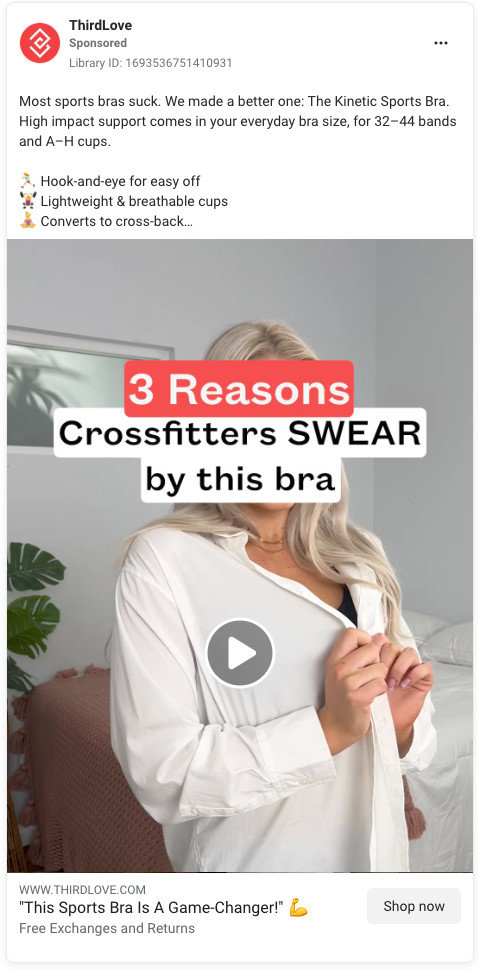
BRUNT Workwear is another example that nails audience-centric creativity by showing their rugged, waterproof sweatshirt in action with a simple but effective demo.
In one Meta ad, they spray a hose directly on the sweatshirt, instantly proving its durability. There’s no fluff or over-the-top production—just a straightforward visual that says, “We know what you need, and we’re here to deliver.”
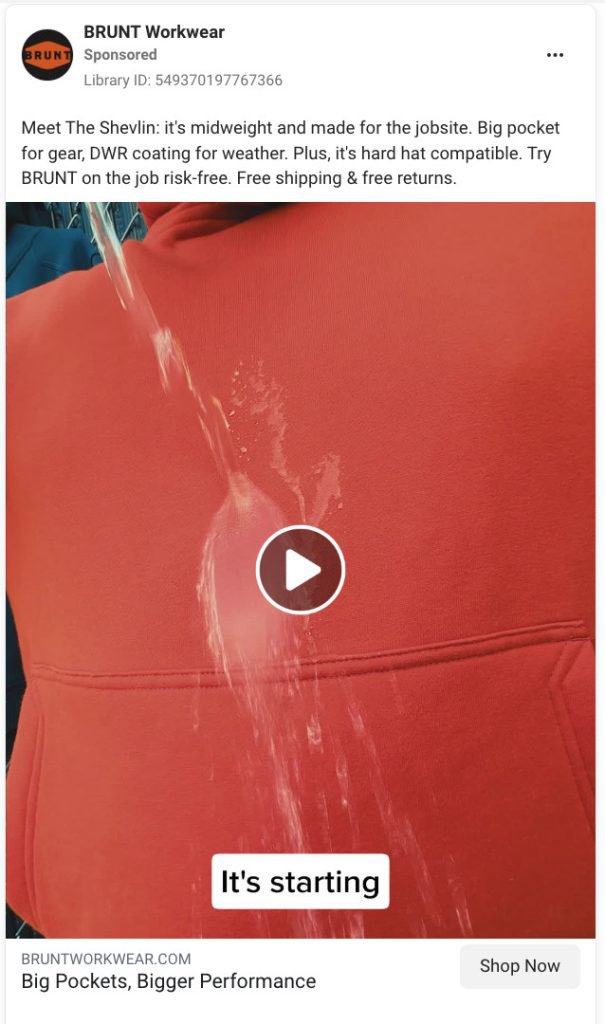
Both of these ads resonate with their specific audience by using visuals that focus on needs and functionality.
Personalizing Your Meta Ads: What Works
Crafting Meta ads tailored for your audience means diving into their world and addressing the details that matter most.
Here are five ways top brands do it:
1. Speak Their Language
If your audience loves running, hiking, or hitting the gym, use language that matches that vibe. Talk about “support that moves with you” or “comfort that keeps up.” People will instantly know you’re speaking to them.
2. Address Their Pain Points
Great Meta ads don’t just show off products; they solve problems. True Classic tees, for example, run ads that hint at common frustrations with fit and quality—without naming names.
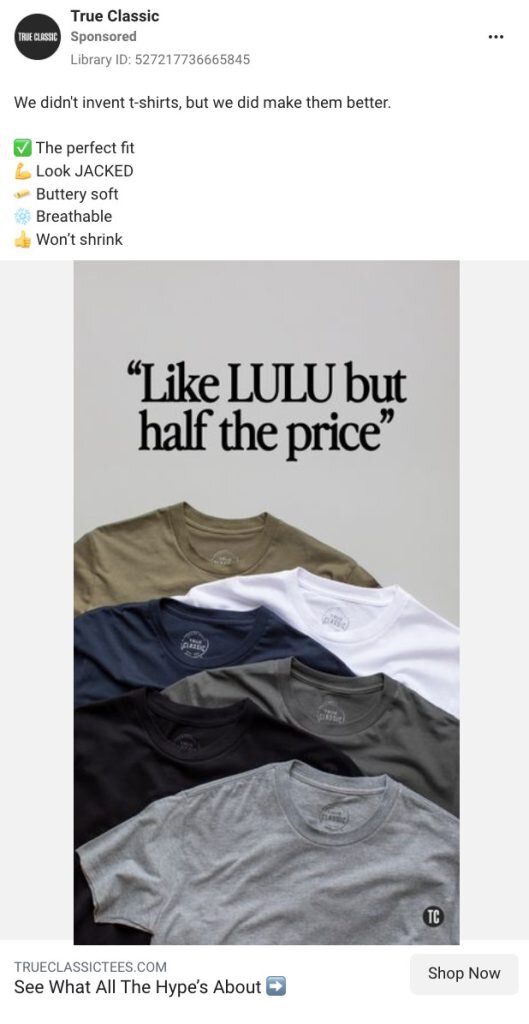
The message is clear: these tees give you quality without breaking the bank.
3. Show Your Product in Action
Ads that feature the product in real-life settings are game-changers. Think about Vuori, whose Meta ads often show people stretching, running, or simply relaxing in their clothing.

Each shot captures the comfort and versatility their audience is looking for.
4. Use Visuals that Resonate
Use images and settings that match your audience’s lifestyle. Whether it’s at the gym, in the kitchen, or on the go, let your visuals do the talking.
Kenny Flowers captures lifestyle-centric visuals by featuring their vibrant, tropical shirts in a TikTok-style Meta ad that feels modern and relatable. In one ad, they use casual “talking head” clips and beachy backdrops to show people living their best island life.
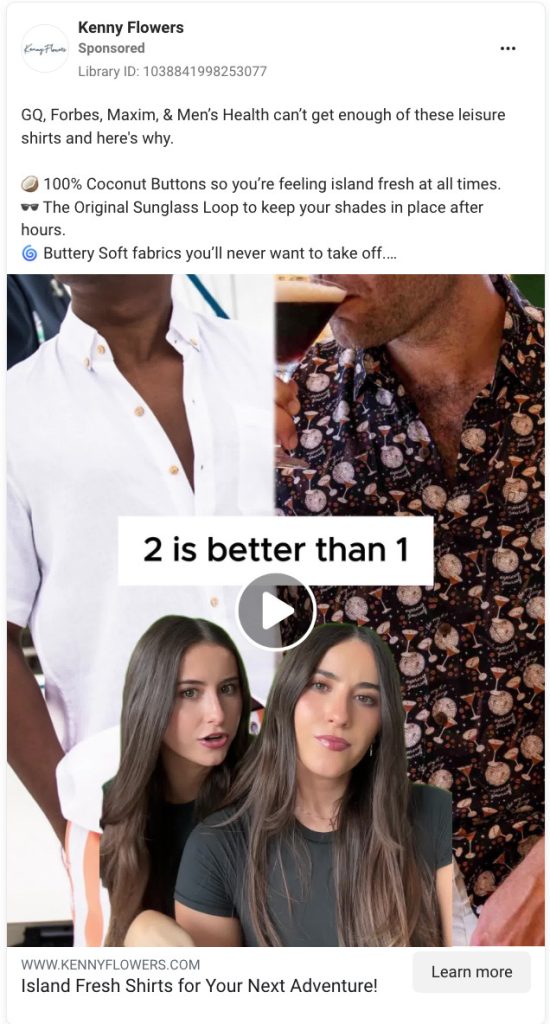
The ad captures the relaxed, fun vibe that their audience, often young travelers or beach lovers, craves.
Plus, this ad doesn’t just show the shirts. It shows the lifestyle that comes with wearing them.
5. Highlight Unique Benefits
Focus on the benefits that matter most to your audience. Maybe it’s comfort, durability, or price. Whatever it is, make it crystal clear why your product fits their needs.
When done right, an audience-centric Meta ads strategy isn’t just more effective. It’s the difference between an ad that blends in and an ad that actually connects.
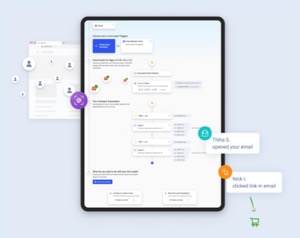
See Who Is On Your Site Right Now!
Get names, emails, phone numbers & more.
Try it Free, No Credit Card Required
Meta Ads Strategy 2: Authenticity and Realness
When it comes to Meta ads, brands that keep it real are the ones making the strongest connections.
Remember – customers are savvy. They want to know there’s a real story behind the ad, not just another polished sales pitch. That’s why authenticity is such a powerful tool in building loyalty. Showing the true, unfiltered side of your brand invites people in and creates trust that goes beyond a single purchase.
Why Authenticity Wins
An authentic Meta ads strategy can be the difference between scrolling by and stopping to engage.
Customers want to feel confident that they’re buying from a brand that’s transparent and relatable. When DTC brands use real customers, everyday scenarios, or behind-the-scenes content, it breaks down that barrier between the brand and the audience.
And that’s where loyalty starts.
Keeping It Real: How DTC Brands Do It
Some of the most effective Meta ads look more like a friend’s post than a typical ad. Here’s are a couple examples of how DTC brands use realness to connect with their audience:
Show Real People, Real Reactions
OneBlade uses a video of people reacting to their razors in a giveaway ad.
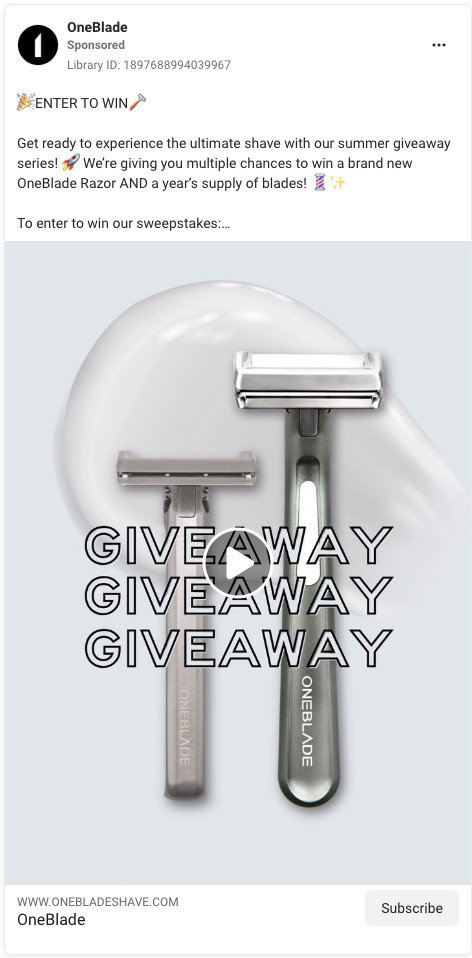
The unscripted excitement and the casual, friendly vibe make it feel genuine and fun—more like a celebration than a sales pitch. It’s an ad that says, “We’re confident in our product, and you’ll love it too.”
Use Influencers for a Candid Feel
DRMTLGY teams up with influencers who casually talk about the products in everyday settings—no scripted lines, just genuine reactions. One ad even features an influencer in her bathroom, casually discussing the product benefits.
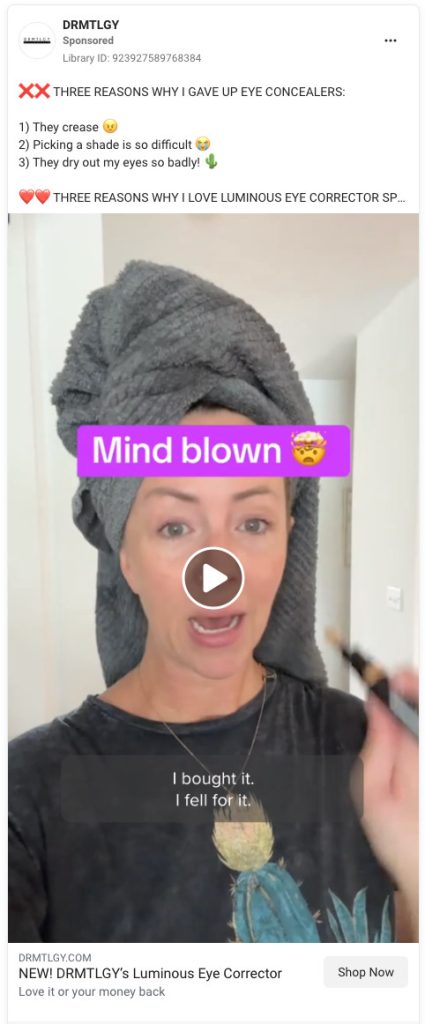
By showing the product as part of real routines, DRMTLGY gives off a vibe of transparency and trustworthiness.
Tips for Adding Realness to Your Meta Ads
Want to give your Meta ads a dose of realness? Here are three ways to keep things authentic:
1. Use User-Generated Content (UGC):
People trust real customers more than models or actors. Featuring UGC is like saying, “Don’t just take our word for it – see what our customers have to say.”
2, Share Behind-the-Scenes Moments:
Letting people peek behind the curtain is a great way to build trust. It could be a quick team video, a snapshot from the warehouse, or a “making of” clip that gives your brand a personal touch.
3. Focus on Everyday Scenarios:
Show how your product fits into daily life. Maybe it’s being used in the kitchen, the gym, or the morning commute. Keeping it grounded in real-life settings helps viewers relate instantly.
Look, a little authenticity can go a long way in Meta ads. When people feel like they’re seeing the real side of your brand, they’re more likely to stick around, engage, and ultimately trust you.
Meta Ads Strategy 3: Visual Storytelling
When you’re scrolling through Meta, a strong visual can do the talking before you even read a single word.
That’s the power of visual storytelling for Meta ads strategy: it captures attention instantly and gets your message across in seconds.
For DTC brands, it’s the perfect way to convey the “why” behind the product, showing off benefits that resonate right away.
Why Visual Storytelling Works
We all know people process visuals faster than text, so when an ad tells a quick, compelling story through imagery, it’s like a shortcut to engagement.
Visual storytelling is your chance to showcase transformations, highlight features, and give people a peek at how your product fits into their lives – all without needing a ton of words.
Done right, it makes your product feel real, relatable, and easy to imagine using.
How Top DTC Brands Nail Visual Storytelling
These brands are pros at showing—not just telling—why their product matters:
Show Transformation with Before-and-After Shots
Knix grabs attention by showing the difference between their modern period underwear and old-school pads in a straightforward visual comparison.
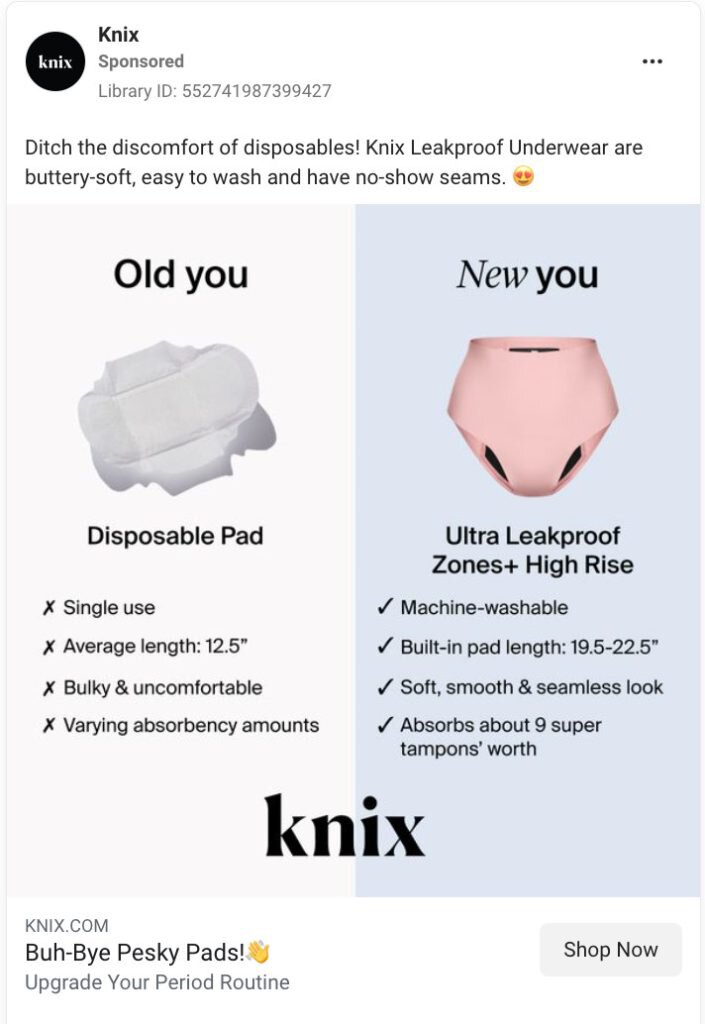
The message? Knix offers a fresh, practical alternative. It’s quick, powerful, and lets the visuals do the convincing.
Demonstrate Your Product in Action
Misen uses a carousel ad featuring their chef’s knife slicing through a variety of foods and materials, showing its strength and versatility.
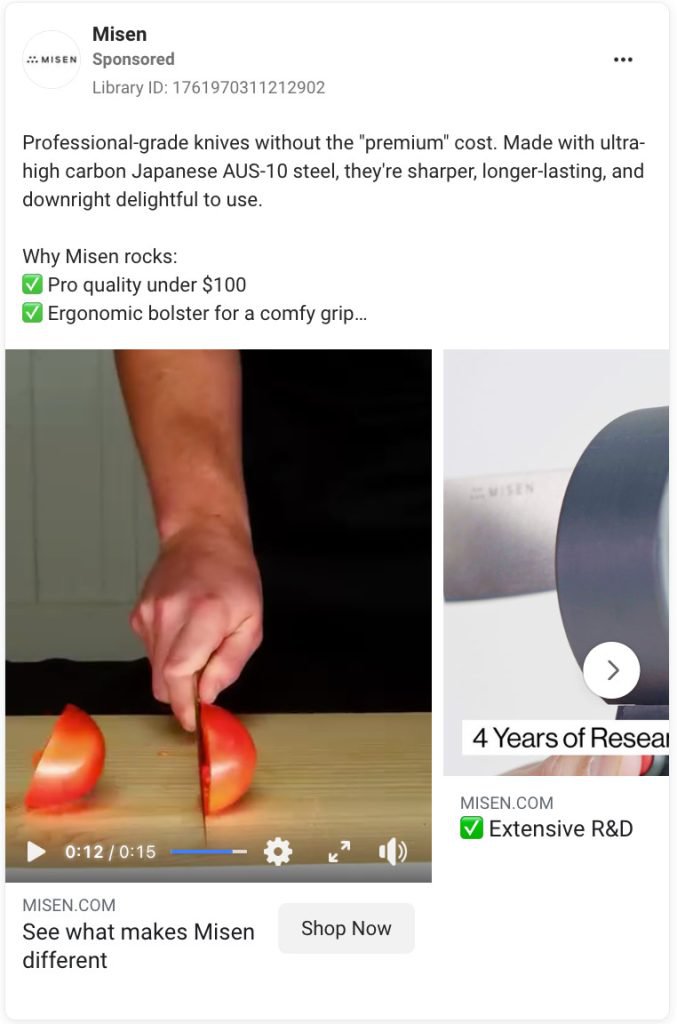
With each slide, viewers get a clear, visual demonstration of the product’s quality without needing a single line of heavy text.
Tips for Bringing Visual Storytelling into Your Meta Ads
Want to make your visuals do the heavy lifting? Here are some simple but effective ways to weave storytelling into your Meta ads:
Use Before-and-After Comparisons
Whether it’s a skincare routine or a kitchen gadget, before-and-after shots can highlight the product’s impact. A powerful transformation can stop the scroll and make viewers think, “I want that result.”
Feature the Product in Real-Life Scenarios
Help people visualize the product in their daily life by showing it in action. From home use to outdoor adventures, real-life settings add context that makes your ad feel relevant.
Create a Narrative with Carousel or Video Formats
If you have a lot to show, try using a carousel or video. Each slide or scene can reveal a new benefit, feature, or transformation, pulling viewers into a mini-story that showcases your product’s full range.
With a Meta ads strategy with visual storytelling, your ads become more than just promotions. They become experiences that draw people in and make them feel connected to your brand.
Key Takeaways: Building a Winning Meta Ads Strategy
When it comes down to it, a successful Meta ads strategy isn’t about following a one-size-fits-all formula…it’s about experimenting, refining, and discovering what works best for your unique audience.
By focusing on these three core strategies, you’re setting your brand up to stand out and connect on a deeper level:
- Audience-Centric Creativity: Speak directly to your audience with tailored visuals and messaging that make them feel seen.
- Authenticity and Realness: Build trust by keeping it real. Whether that’s through user-generated content, behind-the-scenes shots, or candid moments.
- Visual Storytelling: Use strong visuals to create an instant connection, showcasing your product’s value through before-and-afters, demos, or relatable settings.
Each of these strategies brings something powerful to the table, and when combined, they turn your Meta ads into more than just ads. They become part of a customer’s journey with your brand.
Don’t be afraid to experiment, switch things up, and find what resonates most with your audience.
Ready to dive deeper into what makes Meta ads truly work?
Download our Meta ads guide 101 Meta Ads from Top DTC Brands to Inspire Your Next Campaign for examples and insider strategies to help you craft scroll-stopping campaigns that engage and convert.

Important Next Steps
- See what targeted outbound marketing is all about. Capture and engage your first 500 website visitor leads with Customers.ai X-Ray website visitor identification for free.
- Talk and learn about sales outreach automation with other growth enthusiasts. Join Customers.ai Island, our Facebook group of 40K marketers and entrepreneurs who are ready to support you.
- Advance your marketing performance with Sales Outreach School, a free tutorial and training area for sales pros and marketers.
FAQs: Meta Ads Strategy for DTC Brands
1. What makes a good Meta ads strategy?
A good Meta ads strategy focuses on audience targeting, authentic messaging, and compelling visuals that connect with viewers. Understanding your audience and tailoring your ads to their needs is essential.
2. How can I ensure my Meta ads are reaching the right audience?
Use Meta’s advanced targeting options to segment by interests, behaviors, location, and demographics. Regularly monitor and adjust your strategy based on engagement metrics to keep your ads on track.
3. Why is visual storytelling important in a Meta ads strategy?
Visual storytelling captures attention faster than text and creates an emotional connection. This helps viewers quickly understand your brand’s value and feel more inclined to engage with the ad.
4. How often should I refresh my Meta ads strategy?
Refreshing your Meta ads strategy every few weeks is ideal to keep it aligned with audience trends and engagement data. Testing new visuals, messaging, and targeting can also improve ad performance over time.
5. What are some effective ways to build authenticity in Meta ads?
Use real customer testimonials, user-generated content, or behind-the-scenes visuals. Authenticity helps build trust and resonates more with viewers, making your ads feel relatable.
6. How can I tailor Meta ads for different audience segments?
Segment your audience based on key characteristics (e.g., age, interests, or purchasing behavior) and create specific ads that speak directly to each segment. Personalizing the message increases relevance and engagement.
7. What budget should I allocate for my Meta ads strategy?
Budgets vary depending on campaign goals, but start small, monitor performance, and adjust as needed. Consider testing different ad types and allocate more budget to the best-performing ones.
8. How can I measure the success of my Meta ads strategy?
Key metrics to track include click-through rate (CTR), engagement rate, conversion rate, and return on ad spend (ROAS). Analyzing these metrics helps you understand what’s working and where to adjust.
9. What role does ad copy play in a Meta ads strategy?
Ad copy is crucial as it provides context and adds emotional appeal. It should be clear, engaging, and aligned with the visuals to create a cohesive message that resonates with the audience.
10. Are carousel ads effective in a Meta ads strategy?
Yes, carousel ads allow you to showcase multiple products, features, or storytelling steps in a single ad. They’re especially effective for demonstrating product versatility or highlighting different benefits.
11. How can video ads enhance my Meta ads strategy?
Video ads are highly engaging and great for storytelling. They’re ideal for showcasing product demonstrations, sharing customer testimonials, or creating a narrative that holds viewers’ attention.
12. How does Meta ads strategy differ for DTC brands compared to other businesses?
DTC brands often focus more on brand storytelling, customer experience, and building direct relationships with customers. A Meta ads strategy for DTC brands emphasizes authenticity, engagement, and conversion.
13. How do I test different Meta ads strategies effectively?
Run A/B tests on various elements, such as visuals, copy, or CTA. Monitor results to see which performs best and apply those insights to future ads.
14. What’s the best way to incorporate UGC into my Meta ads strategy?
UGC adds social proof and authenticity. Feature real customer reviews, testimonials, or photos of them using your product to make the ad feel genuine and trustworthy.
15. How can I make my Meta ads stand out from the competition?
Focus on what makes your brand unique—whether it’s a specific product feature, brand story, or value proposition—and use visuals and messaging that are fresh and eye-catching.
16. What’s the importance of A/B testing in a Meta ads strategy?
A/B testing allows you to compare different ad variations and see what resonates most with your audience. It’s essential for refining your ads and improving overall performance.
17. How does frequency affect my Meta ads strategy?
If an ad’s frequency is too high, viewers may experience ad fatigue. Monitor frequency and refresh or adjust your ads to keep engagement high without overwhelming your audience.
18. Should I focus more on brand awareness or conversions in my Meta ads strategy?
It depends on your goals. For new customers, focus on brand awareness. For retargeting or established audiences, prioritize conversion-based ads to drive actions like purchases.
19. How can I improve my Meta ads’ CTR?
Optimize visuals and ad copy to make it more compelling, use clear CTAs, and ensure your ad targets the right audience. Experiment with different ad formats and styles to find what grabs attention.
20. Why is audience targeting so crucial in a Meta ads strategy?
Audience targeting ensures your ads are shown to the people most likely to be interested in your brand. When your ads reach the right audience, engagement, and conversion rates increase significantly.
